Overview
This article examines how custom workforce intelligence datasets can significantly enhance recruitment success. By providing organizations with essential insights into labor trends, candidate skills, and market demands, these datasets empower businesses to make informed decisions. AI-driven tools from industry leaders like Websets and Lightcast.io play a pivotal role in streamlining hiring processes and elevating candidate quality. As a result, companies can effectively align their recruitment strategies with overarching business goals and adapt to the ever-evolving employment landscape.
Introduction
The recruitment landscape is experiencing a seismic shift, propelled by the integration of custom workforce intelligence datasets alongside AI-powered solutions. Organizations now possess advanced tools that not only streamline the hiring process but also significantly enhance the quality of candidate selection. In this context, it is essential for recruiters to adapt and innovate. However, as the demand for skilled professionals continues to outstrip supply, a pressing question arises: how can companies effectively leverage these insights to navigate talent shortages and improve their hiring outcomes?
This article delves into ten transformative datasets and strategies designed to elevate recruitment success in an increasingly competitive market.
Websets: AI-Driven Solutions for Enhanced Recruiting Strategies
Websets revolutionizes the hiring landscape through advanced , enabling organizations to efficiently identify and connect with qualified candidates. Its in-house developed search engine, tailored specifically for LLMs, empowers recruiters to navigate extensive custom workforce intelligence datasets, ensuring precise talent acquisition based on targeted criteria. By enriching search results with comprehensive insights—including LinkedIn profiles, emails, company details, and prior work experience—Websets significantly elevates the quality of leads. This capability not only streamlines the hiring process but also aligns with the increasing trend of skills-based employment, where companies leveraging AI are 12% more likely to achieve quality hires.
Successful implementations of AI in hiring, including Websets' proprietary tools, illustrate how these technologies can shorten hiring timelines while enhancing candidate satisfaction. Furthermore, AI-powered tools automate repetitive tasks, allowing recruiters to focus on strategic initiatives, ultimately fostering a more effective and engaging hiring experience.
Committed to security and compliance, Websets guarantees that all queries and data can be automatically purged according to requirements, upholding the highest standards of industry compliance.
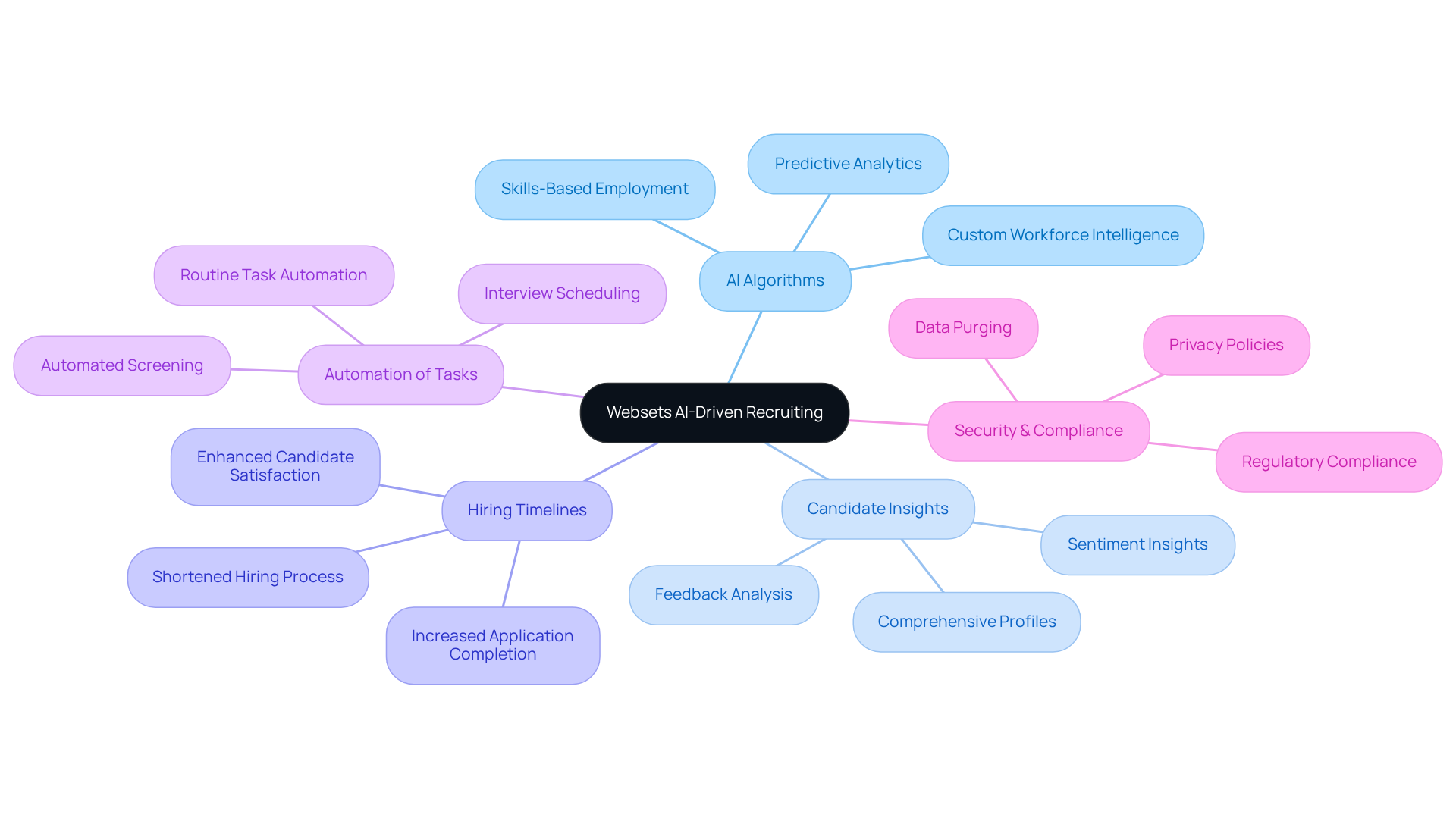
Eightfold.ai: AI-Powered Talent Matching for Effective Recruitment
Websets leverages artificial intelligence to revolutionize the hiring landscape, aligning candidates with job opportunities based on their skills and experiences. This innovative platform processes extensive custom workforce intelligence datasets to identify the most suitable candidates, significantly reducing the time spent on manual screening. By prioritizing potential over mere past experiences, Websets empowers organizations to uncover hidden talents, thereby enhancing the effectiveness and inclusivity of their hiring initiatives.
With and qualification features, Websets enables recruiters to filter candidates by skills, experience, and location, enriching profiles with vital details such as LinkedIn information and previous work experience. As AI adoption in hiring continues to surge—evidenced by 70% of global employers already utilizing these technologies—platforms like Websets are leading the charge in redefining hiring strategies and improving overall talent acquisition outcomes.
According to Keith Ferrazzi, a contributor at Forbes, 'AI is rapidly evolving beyond a supporting role to become the driving force behind recruitment.' This statement underscores the transformative impact of AI tools like Websets in identifying skills gaps and anticipating future hiring needs, which rely on custom workforce intelligence datasets to become indispensable in today’s competitive employment landscape. Are you ready to embrace this change and enhance your hiring process?
Lightcast.io: Workforce Intelligence for Strategic Talent Acquisition
Lightcast.io provides sophisticated solutions that utilize custom workforce intelligence datasets to deliver critical insights into labor trends and the availability of skilled individuals. By meticulously analyzing data from job postings, skills demand, and industry developments, Lightcast.io empowers organizations to refine their talent acquisition strategies. This data-driven methodology enables recruiters to pinpoint skill gaps and adapt their hiring practices effectively. With a staggering 75% of employers , leveraging such insights is essential for remaining competitive in the evolving employment landscape. Companies increasingly recognize the significance of data in hiring; those utilizing Lightcast.io's analytics can enhance their employment outcomes and align their workforce with market demands.
Moreover, integrating Websets' AI-driven tools can further elevate hiring strategies by providing deeper insights and analytics tailored to specific industry needs. As we approach 2030, the anticipated global workforce deficiency of approximately 85 million individuals underscores the urgency of employing custom workforce intelligence datasets in hiring strategies.
Actionable Tip: Consider integrating Lightcast.io's analytics alongside Websets' tools into your hiring process to gain a better understanding of market demands and improve your talent acquisition outcomes.
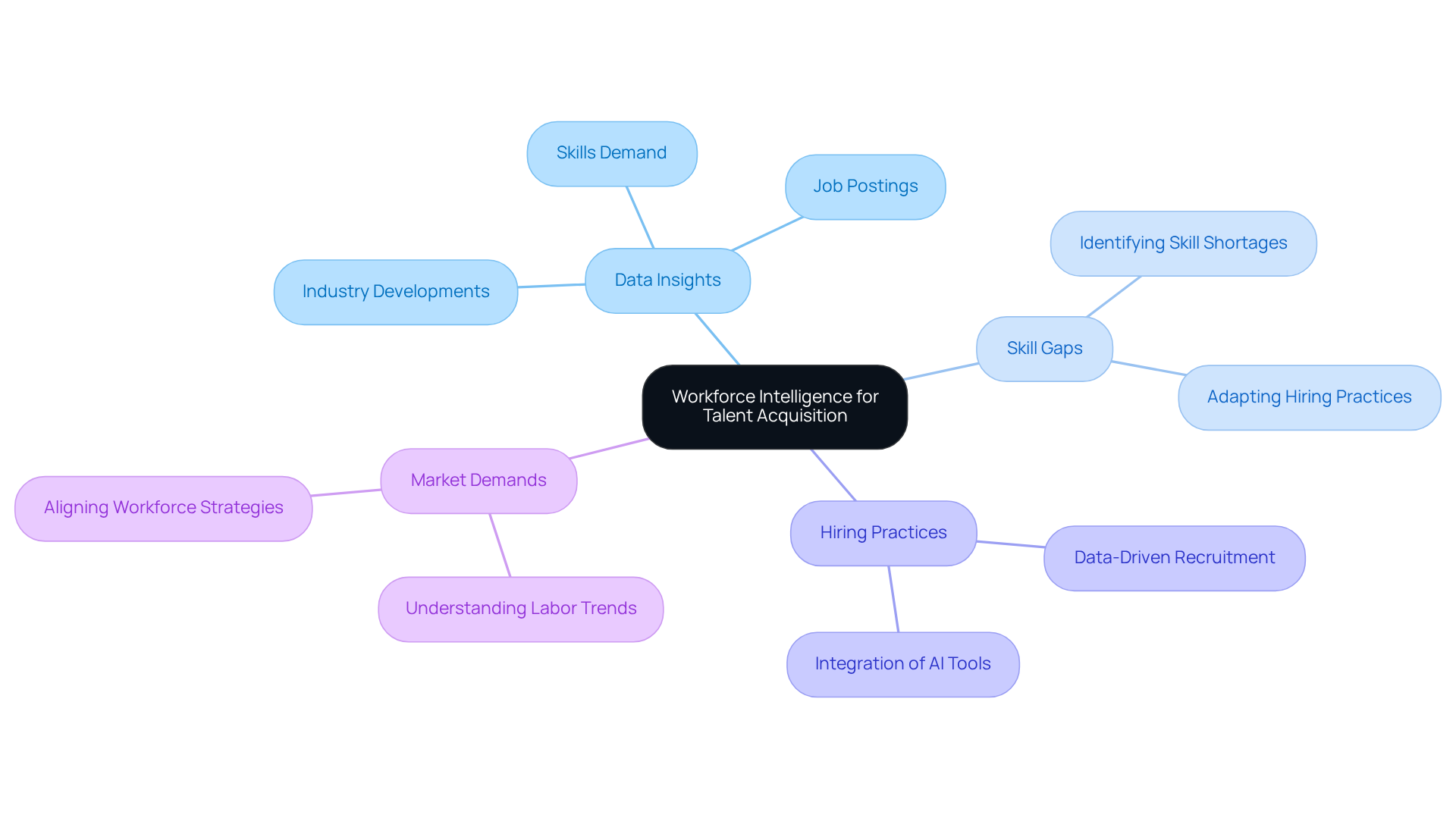
Revelio Labs: Comprehensive Workforce Database for Recruitment Insights
Websets offers a robust solution for that leverages advanced neural search technology to deliver critical insights into employee movements, skills, and organizational structures. This data is essential for recruiters aiming to navigate the competitive landscape and pinpoint potential candidates effectively. By utilizing Websets' comprehensive datasets and AI-driven tools, companies can enhance their hiring strategies through custom workforce intelligence datasets, ensuring informed employment choices that align with their specific needs.
Understanding employee movements is crucial for effective recruitment. Recognizing where skilled individuals are moving assists organizations in identifying skill gaps and emerging trends in the job market. Companies that analyze employee movement data through Websets' neural search capabilities can uncover patterns that contribute to custom workforce intelligence datasets, indicating which sectors are experiencing growth and where talent is becoming scarce.
Recruitment experts emphasize the importance of leveraging employee movement data to enhance hiring effectiveness. Entities that have effectively incorporated this data into their hiring processes report enhanced candidate quality and decreased time-to-hire. A leading tech firm, for instance, utilized Websets' insights to adjust its hiring strategy, resulting in a 30% increase in the quality of hires over six months.
Furthermore, skills analysis obtained from custom workforce intelligence datasets can significantly influence hiring results. By understanding the in-demand skills and how they align with organizational needs, recruiters can target their efforts more effectively. This tactical approach not only improves hiring success but also cultivates a more flexible workforce, capable of adapting to shifting industry requirements.
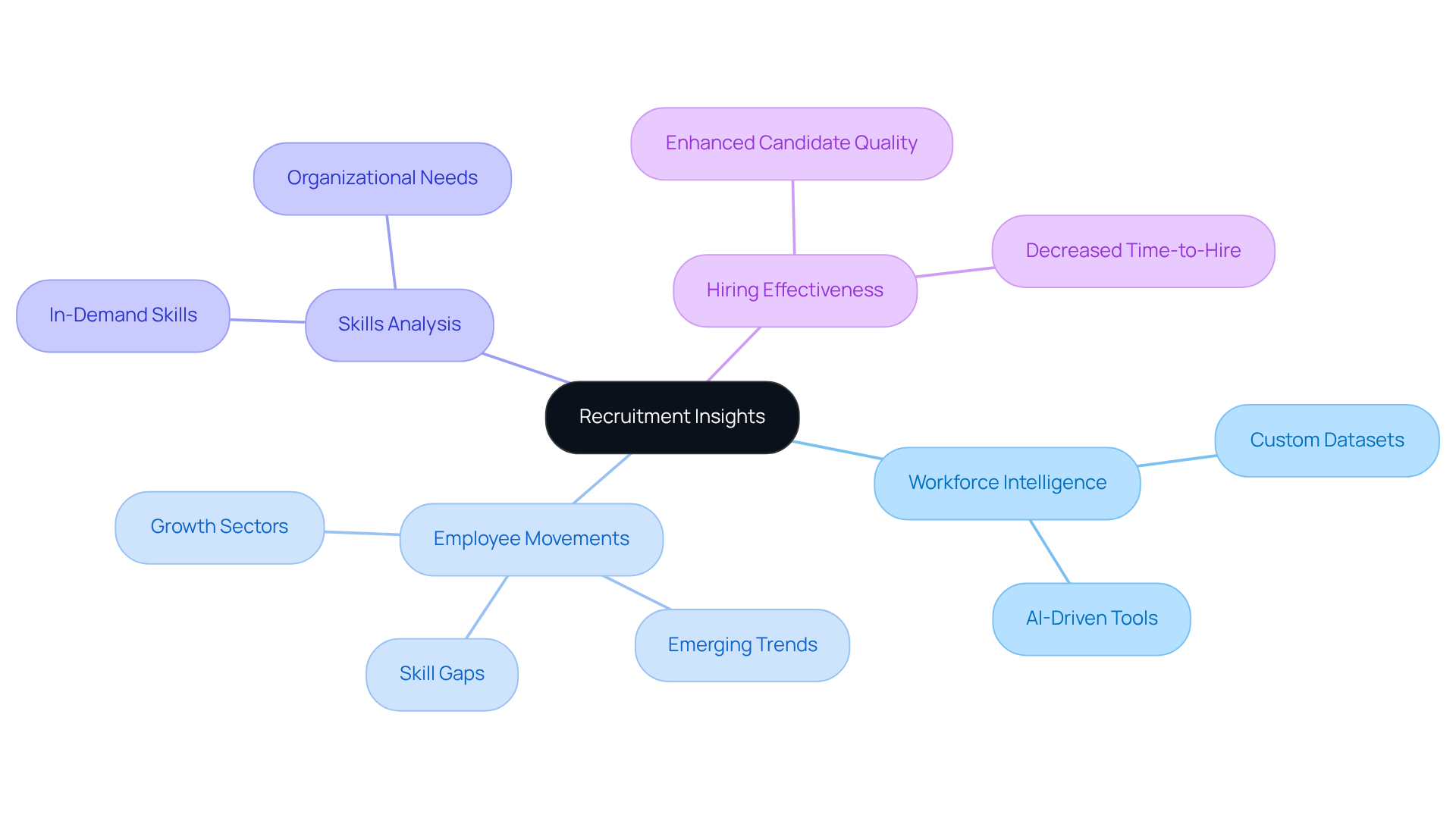
NiCE: Implementing Workforce Intelligence for Better Recruitment
NiCE is at the forefront of implementing solutions using custom workforce intelligence datasets that dramatically enhance hiring processes. By seamlessly integrating data analytics into hiring strategies, organizations achieve a profound understanding of candidate profiles and market demands. This not only streamlines hiring efforts but also leads to superior outcomes and more efficient talent acquisition.
As we look toward 2025, the emphasis on hiring analytics has never been more pronounced. Companies are increasingly recognizing the importance of tracking key metrics such as time-to-fill and quality of hire.
Organizations that leverage [Websets' advanced AI-powered search engine](https://insights.exa.ai/10-benefits-of-investor-focused-hiring-dataset-subscriptions) can utilize features like the Fast API and Research Agentic API to refine their hiring strategies. These tools provide access to the most relevant and enriched data, facilitating informed hiring decisions.
In a rapidly evolving recruitment landscape, harnessing custom workforce intelligence datasets is essential for companies aiming to remain competitive and attract top talent.
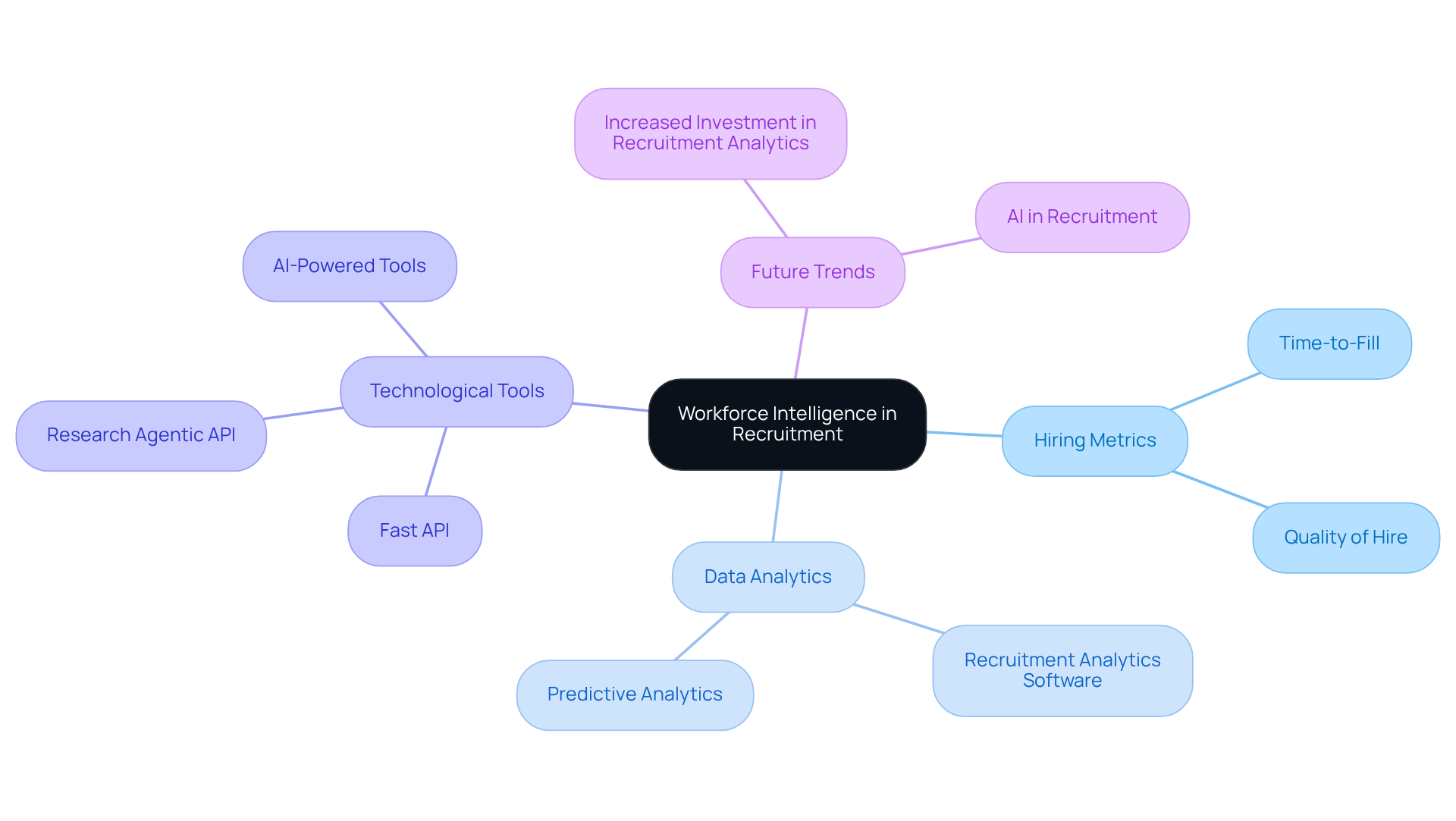
Workforce Intelligence Data: Unlocking Growth Opportunities in Recruitment
Workforce intelligence data offers organizations vital insights into labor conditions, skill availability, and competitive dynamics. Leveraging this data enables recruiters to identify growth opportunities and refine strategies that align with current market demands. With the U.S. economy projected to create six million jobs before 2029, understanding these trends is essential for attracting skilled individuals. Notably, 56% of employers cite talent shortages as a major challenge, underscoring the necessity for proactive hiring strategies.
Organizations such as Schneider Electric exemplify the effective use of AI-powered platforms to enhance internal mobility, showcasing how data-driven insights can lead to superior hiring practices. Furthermore, 70% of executives expect an increase in hiring temporary and contract workers this year, reflecting a notable shift in workforce dynamics that recruiters must adeptly navigate.
Industry leaders emphasize the importance of evolving hiring strategies to treat the selection process like a marketing campaign, focusing on building applicant pools and ensuring a positive candidate experience. Considering that 66% of job candidates accept offers due to favorable experiences, companies must prioritize transparency and communication throughout the hiring journey.
In conclusion, harnessing custom workforce intelligence datasets not only aids companies in identifying growth opportunities but also empowers them to respond effectively to evolving labor market conditions, ultimately enhancing their recruitment success.
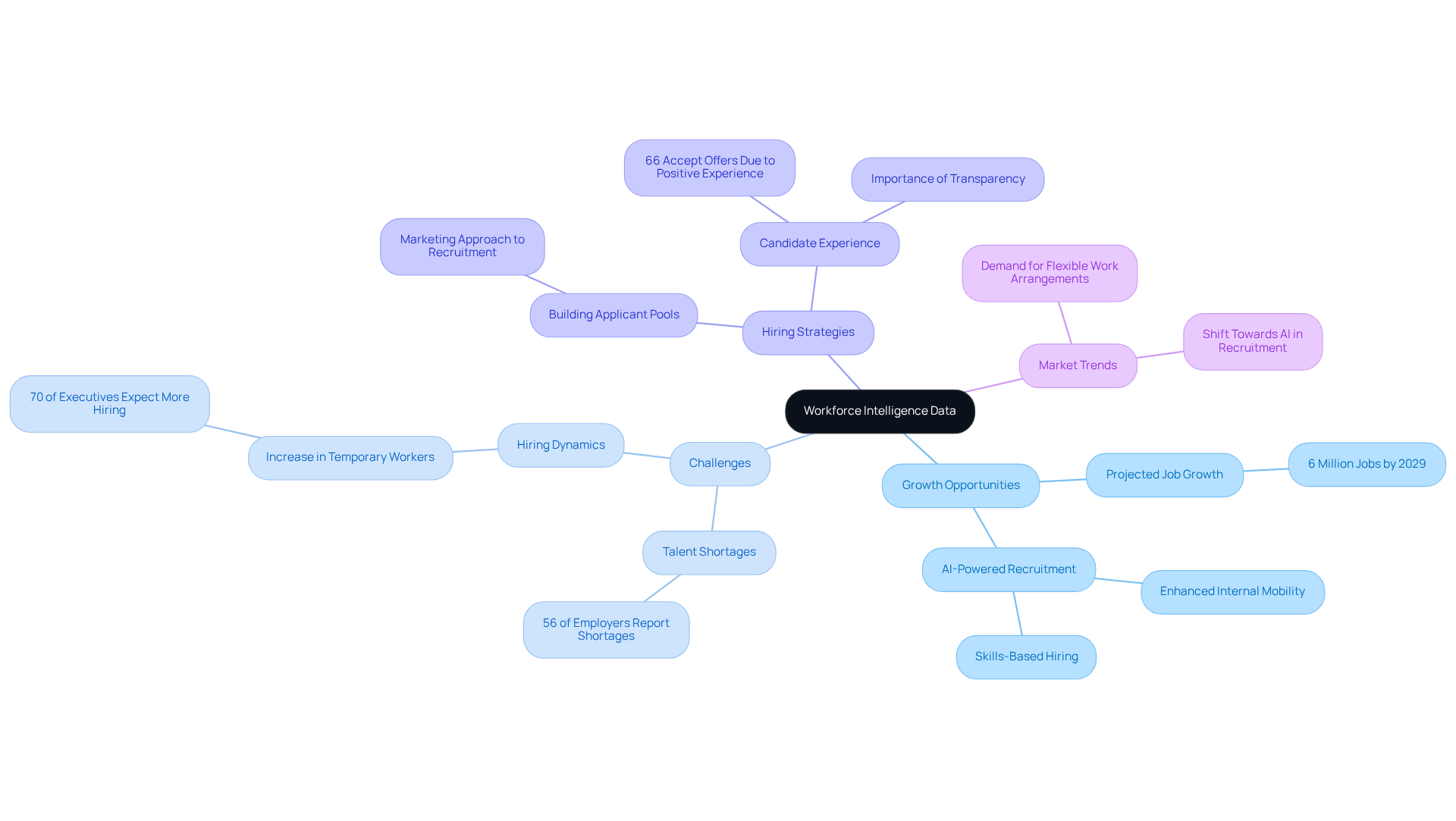
Compensation Insights: Attracting Top Talent Through Competitive Offers
Compensation insights are crucial for companies striving to attract and retain top talent in a fiercely competitive landscape. By thoroughly analyzing industry salary benchmarks and compensation packages, recruiters can craft offers that truly stand out. In 2024, the median total cash compensation for internal recruiters reached $91,000, reflecting a modest rise from the previous year. This underscores the necessity for companies to stay attuned to .
Research shows that professionals who received a bonus earned, on average, $21,000 more than their counterparts without bonuses, despite having similar base salaries. This emphasizes the importance of integrating performance-based incentives into compensation strategies. Furthermore, nearly 70% of organizations are encountering challenges in filling full-time roles, often due to a lack of attractive offers. As a result, companies that prioritize appealing compensation packages are more likely to attract qualified candidates and reduce turnover rates.
Experts assert that well-structured compensation programs are essential for achieving strategic business objectives. Bob Lemke, Director of Human Capital Consulting, notes that competitive compensation is foundational for attracting and retaining talent in today’s market. Moreover, organizations that regularly benchmark their salary proposals can identify optimization opportunities, ensuring they remain competitive.
Bryan Lake, Vice President, highlights that "Organizations see efficiency and productivity erode, driving up operational costs," which emphasizes the broader implications of not providing competitive compensation. Case studies indicate that companies implementing robust compensation strategies experience enhanced employee engagement and retention. For instance, organizations with flexible work arrangements report fewer hiring challenges compared to those that do not, suggesting that a comprehensive approach to compensation—including work-life balance—can significantly improve hiring success. By leveraging data on compensation packages and industry standards, recruiters can formulate compelling offers that not only attract top candidates but also foster long-term loyalty.
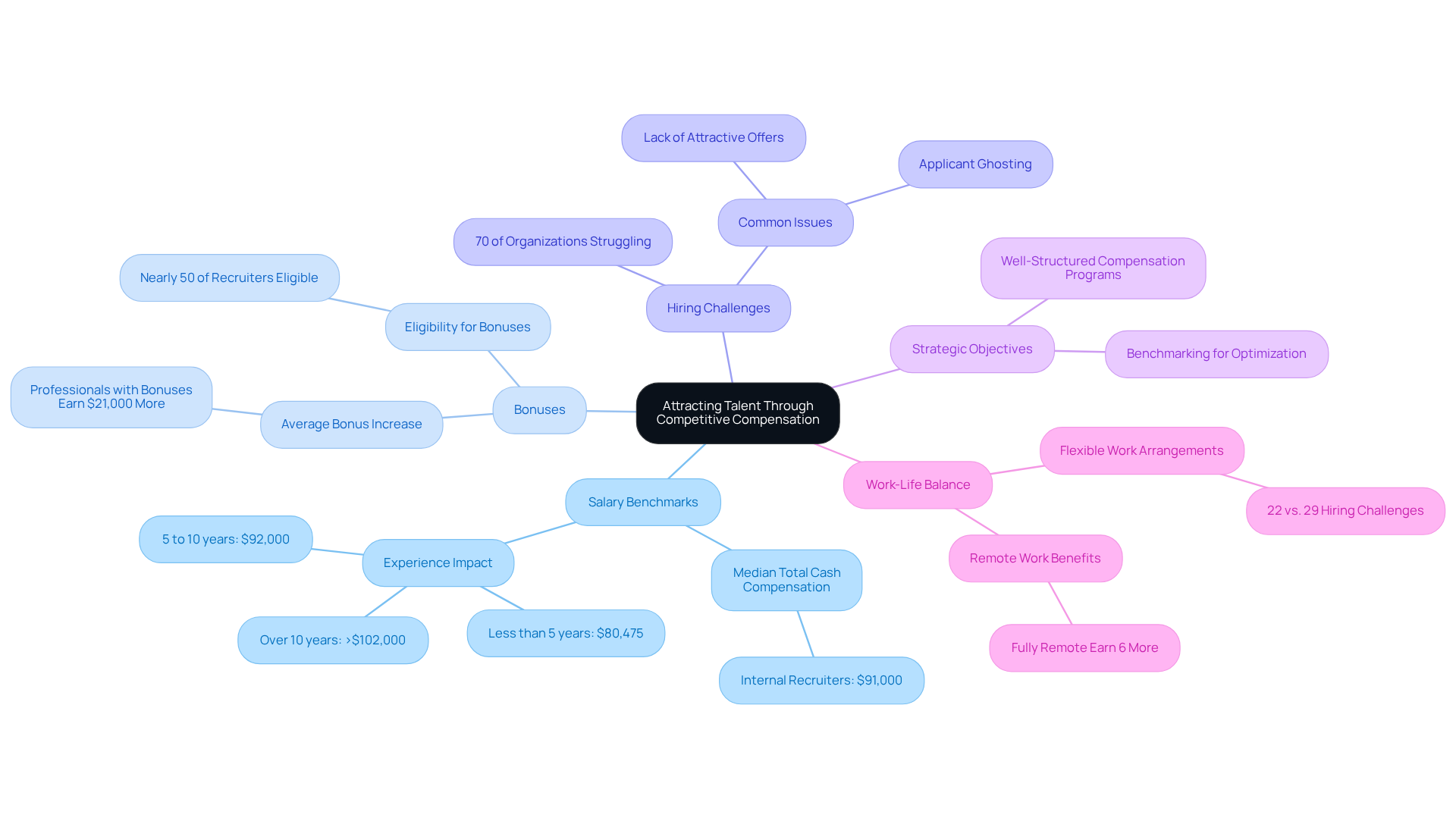
Strategic Workforce Planning: Aligning Recruitment with Business Goals
Strategic workforce planning is essential for aligning hiring efforts with an organization's overarching business goals. By clearly understanding the skills and roles necessary for achieving these objectives, recruiters can strategically target their efforts to attract the right candidates. This proactive alignment transforms hiring from a mere reactive process into a strategic initiative that fosters long-term organizational success.
In fact, studies show that nearly 4 out of 5 employers worldwide faced challenges in locating skilled professionals in 2023. This statistic underscores the critical need for . Aligning hiring processes with business objectives not only enhances the quality of hires but also improves retention rates. Candidates who resonate with the company's vision and culture are more likely to contribute positively.
Organizations that view hiring as a vital factor for competitive advantage can better align their acquisition strategies with business goals. This alignment results in improved performance metrics, such as time-to-fill and quality-of-hire. By incorporating ongoing enhancements in hiring strategies—through regular assessment of hiring analytics and exit interviews—companies can ensure that their selection processes evolve alongside changing business priorities.
Moreover, engaging senior leaders in the recruitment process is crucial for identifying the skills required to achieve business goals. As Bradford Jacobs notes, "Aligning recruitment with company objectives becomes even more intricate when expanding globally or entering unfamiliar territories." This collaboration fosters a more agile and responsive workforce, ultimately enhancing team dynamics and workplace morale. As companies expand into new areas, aligning workforce acquisition with strategic growth initiatives becomes increasingly essential. This alignment ensures that each hire strengthens the organization's capabilities and supports its growth trajectory.
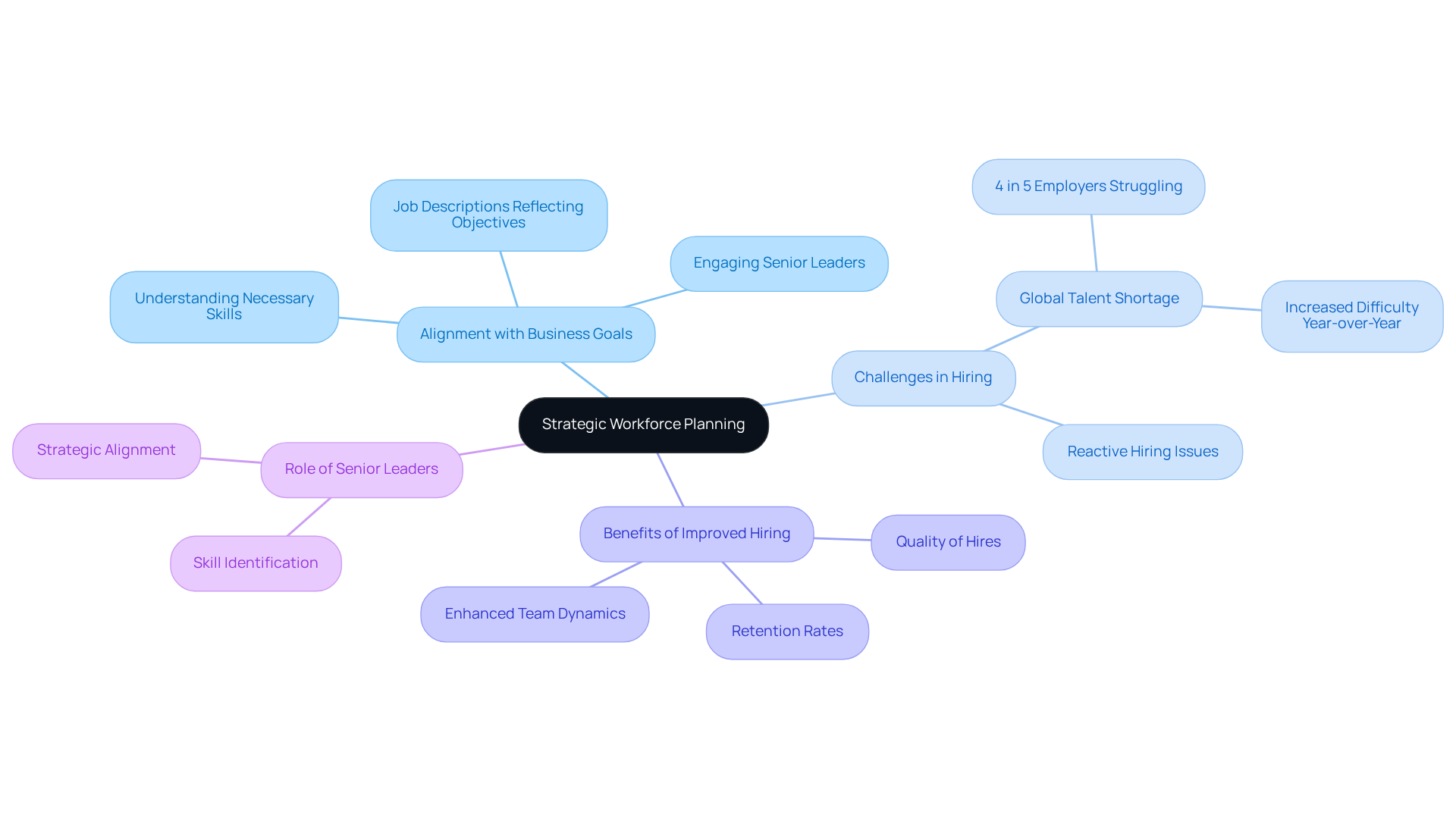
Labor Market Trends: Adapting Recruiting Strategies for Competitive Advantage
Labor trends significantly influence recruitment strategies, compelling organizations to remain vigilant about shifts in skill demand and industry needs. By year-end 2025, skills in demand will include:
- AI literacy
- Cybersecurity
- Leadership
- Change management
- Soft skills
across various industries. As automation and AI reshape job roles, employers are responding by investing in upskilling initiatives to ensure their workforce remains competitive.
Organizations like Marsh McLennan have successfully implemented digital tools to enhance employee well-being, which in turn boosts productivity and job satisfaction. This proactive approach not only attracts top talent but also retains current employees by fostering a .
Recruiters must adapt their strategies to these market changes. For instance, employers are shifting from conventional job boards and local talent sources to diversify their hiring channels, utilizing social media and specialized platforms to access a wider talent pool. Additionally, offering flexible work arrangements has become essential, as candidates increasingly prioritize work-life balance.
In this changing environment, utilizing advanced technologies such as neural search can greatly improve hiring initiatives. By employing AI-driven solutions, organizations can better understand the semantic qualities of job seekers and their skills, leading to more effective B2B lead generation and data discovery. Experts emphasize that understanding these dynamics is crucial for effective recruitment. As Roy Maurer observed, 'Workers who cannot adapt and acquire these new skills will be left behind in their employment opportunities.' By concentrating on sought-after skills and demonstrating adaptability, companies can enhance their appeal to prospective employees, ensuring they remain competitive in a swiftly changing job market.
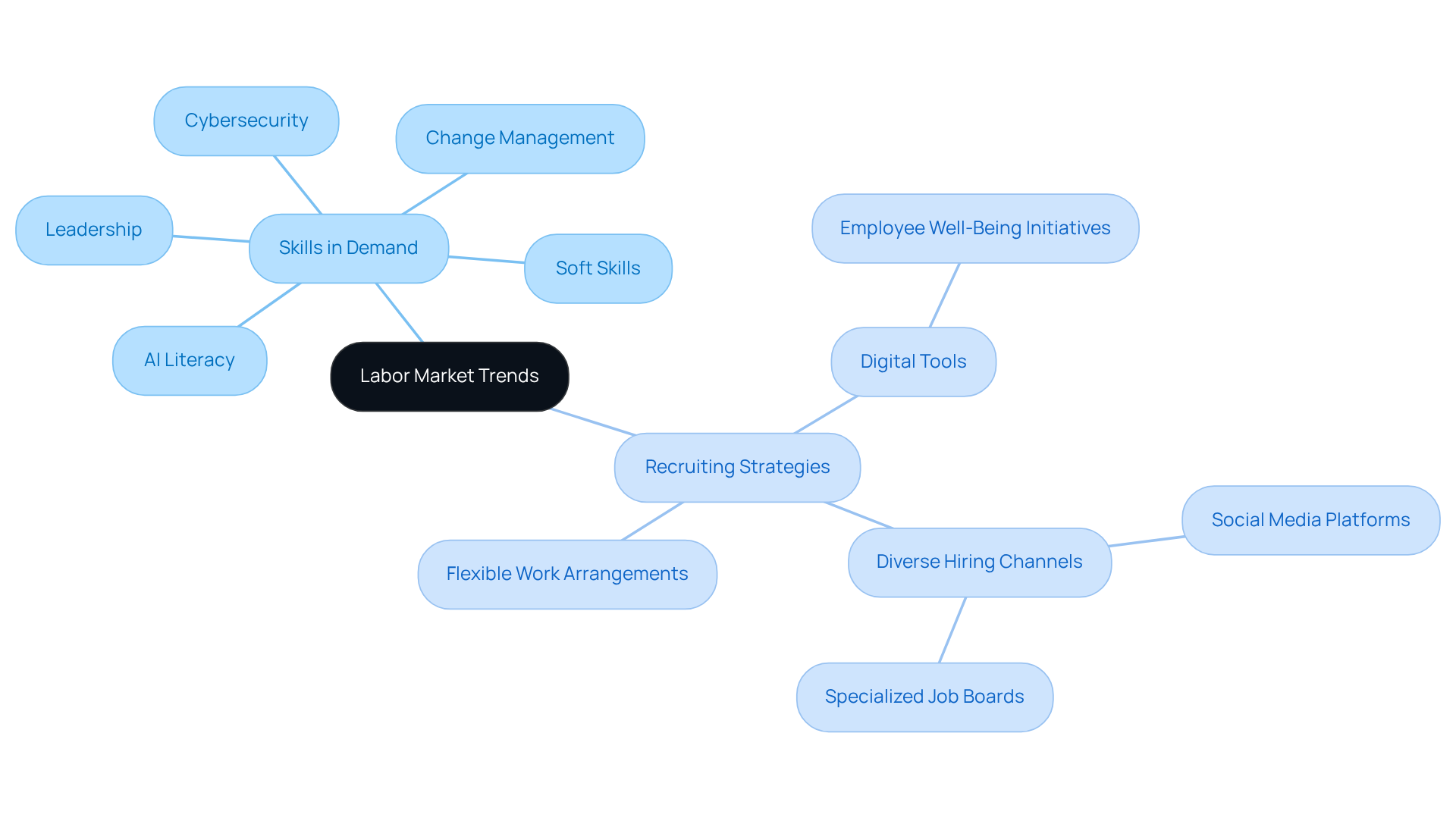
Upskilling Initiatives: Building a Pipeline of Qualified Candidates for Recruitment
Upskilling initiatives are vital for organizations looking to develop a strong pipeline of qualified candidates. By strategically investing in training and development programs, companies can equip their workforce with the skills necessary to effectively navigate future challenges. This proactive approach not only enhances recruitment efforts but also significantly boosts employee loyalty and retention rates. For example, tech giants like Google and Microsoft are investing billions into training programs to ensure their workforce remains competitive and skilled. HR leaders emphasize that building a workforce pipeline through comprehensive training is essential; as Erin Scruggs noted, 'There’s a real mismatch right now between job seekers and hirers.'
Moreover, organizations that prioritize upskilling are better positioned to adapt to the changing job market, where the demand for AI-skilled individuals has surged by over 300% in recent years. With projections indicating that 85 million jobs may be displaced by 2025 due to labor shifts between humans and machines, fostering a is crucial. Addressing disparities in access to training opportunities based on geography, socioeconomic status, and age allows businesses to attract top talent and retain it, ultimately driving long-term success.
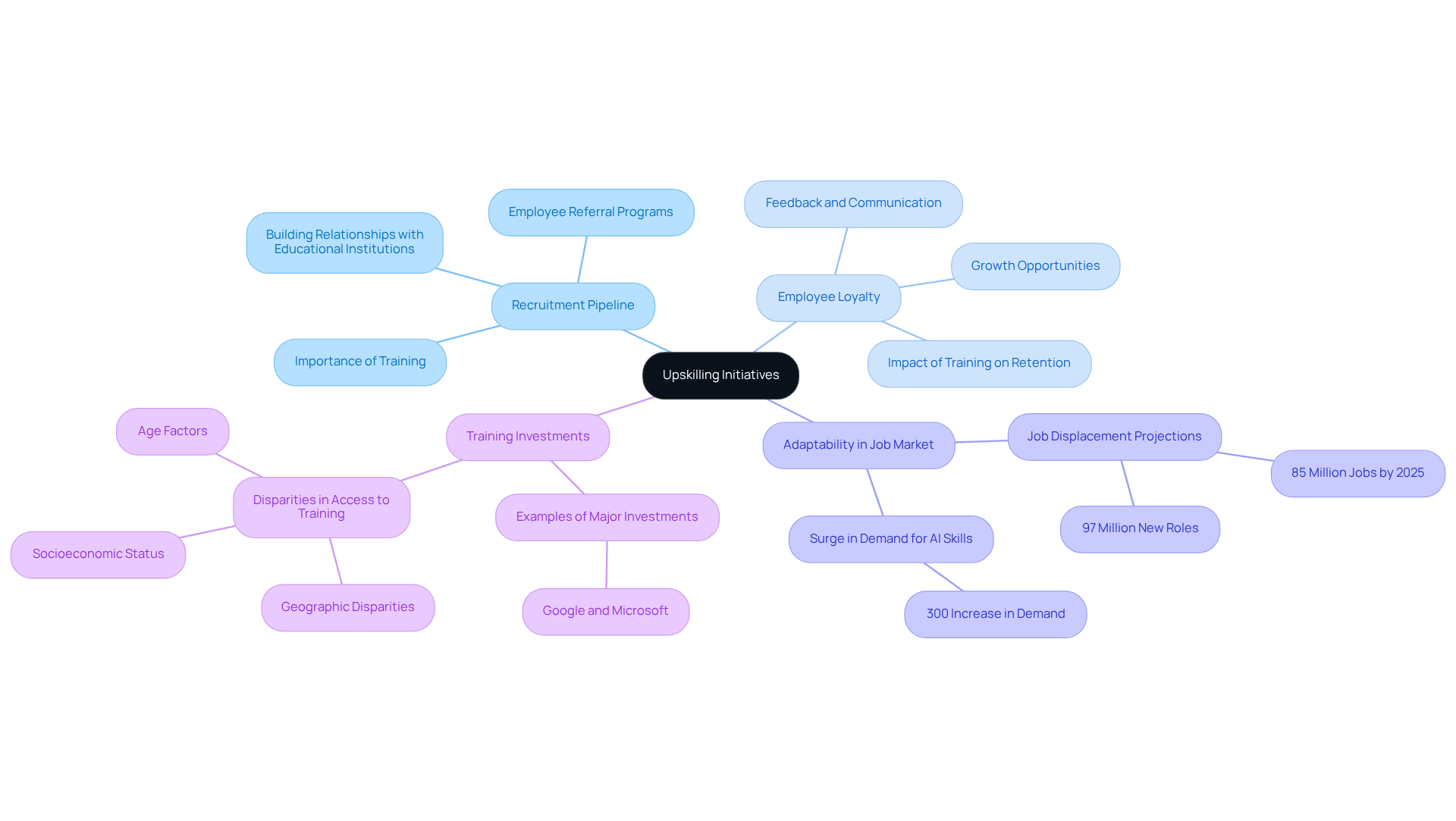
Conclusion
Harnessing custom workforce intelligence datasets is not just beneficial; it is essential for modern recruitment success. The integration of AI-driven solutions empowers organizations to streamline their hiring processes, improve candidate matching, and ultimately enhance the quality of hires. By leveraging advanced analytics and insights, companies can effectively navigate the complexities of the labor market, making informed decisions that align with their strategic objectives.
Throughout this discussion, various platforms such as Websets, Eightfold.ai, Lightcast.io, and Revelio Labs exemplify the transformative potential of workforce intelligence in recruitment. These tools are instrumental in identifying skill gaps and predicting future hiring needs, enabling organizations to adapt their strategies in response to evolving market demands. Furthermore, the emphasis on competitive compensation and upskilling initiatives underscores the multifaceted approach necessary to attract and retain top talent.
As the recruitment landscape continues to evolve, embracing these innovative solutions is crucial for organizations aiming to stay ahead of the competition. By prioritizing workforce intelligence and strategic planning, companies can enhance their recruitment outcomes while fostering a more agile and capable workforce, ready to meet future challenges. Engaging with these insights and tools will empower organizations to refine their hiring strategies and build a strong foundation for long-term success.
Frequently Asked Questions
What is Websets and how does it enhance recruiting strategies?
Websets is an AI-driven platform that revolutionizes the hiring process by using advanced algorithms to identify and connect organizations with qualified candidates. It features a tailored search engine that navigates extensive custom workforce intelligence datasets, enriching search results with insights like LinkedIn profiles, emails, company details, and prior work experience.
How does Websets improve the quality of candidate leads?
Websets enhances the quality of candidate leads by providing comprehensive insights that allow recruiters to make informed decisions based on targeted criteria, aligning with the trend of skills-based employment and increasing the likelihood of quality hires.
What benefits does AI bring to the hiring process according to Websets?
AI in hiring, as demonstrated by Websets, shortens hiring timelines, enhances candidate satisfaction, and automates repetitive tasks, enabling recruiters to focus on strategic initiatives for a more effective hiring experience.
How does Websets ensure data security and compliance?
Websets is committed to security and compliance by guaranteeing that all queries and data can be automatically purged according to requirements, maintaining high industry standards.
What role does Eightfold.ai play in the recruitment process?
Eightfold.ai, similar to Websets, utilizes AI to match candidates with job opportunities based on their skills and experiences, significantly reducing the time recruiters spend on manual screening.
How does Websets address the issue of hidden talents in the hiring process?
Websets empowers organizations to uncover hidden talents by prioritizing potential over past experiences, thus enhancing the inclusivity and effectiveness of hiring initiatives.
What insights does Lightcast.io provide for talent acquisition?
Lightcast.io offers sophisticated solutions that analyze labor trends and the availability of skilled individuals, helping organizations refine their talent acquisition strategies and pinpoint skill gaps.
Why is data important in hiring according to Lightcast.io?
Data is crucial in hiring as it helps employers understand market demands and improve employment outcomes, especially as many struggle to fill job vacancies.
What is the anticipated global workforce deficiency by 2030?
By 2030, there is an anticipated global workforce deficiency of approximately 85 million individuals, highlighting the urgency of employing custom workforce intelligence datasets in hiring strategies.




